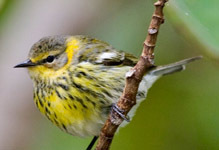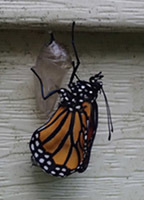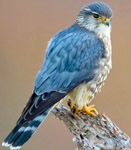Hudson River Almanac 9/1/18 - 9/7/18
The New York State Department of Environmental Conservation sent this bulletin on 09/14/2018 02:09 PM EDT |
| DEC Delivers - Information to keep you connected and informed from the NYS Department of Environmental Conservation |
| Share or view as a web page || Update preferences or unsubscribe |
|
Compiled by Tom Lake, Hudson River Estuary Program Consulting NaturalistOverviewOppressive heat was the story of the week along the estuary from Albany to New York City. A slow early-season migration of raptors was noted from the hawkwatches and a quiet river still revealed its young-of-year fishes heading seaward. Highlight of the Week9/4 – Rockland County, HRM 31: I spotted an early pair of kestrels at the Hook Mountain Hawkwatch moving together southwest. In late morning, a merlin was hunting the west summit woods. During the noon hour, an American kestrel was moving southwest when it was attacked by a big Cooper's hawk that chased the falcon in earnest across the valley. The kestrel got away. One final kestrel harnessed a short-lived north breeze to cruise effortlessly past on a long reach north of Hook Mountain. Non-raptor observations included three monarch butterflies, as well as black swallowtails, tiger swallowtails, red-spotted purples, and skimmer dragonflies (maybe twelve-spotted). Natural History Entries[The banner photo in last week’s Hudson River Almanac featured Peter Johnson’s photo of a redbelly turtle (Pseudemys rubriventris). We received comments from readers on the apparent “scute shedding” on the carapace in the photo. Our reptile expert Alvin Breisch commented, “... some turtles shed the outer layer of the scute as a single piece not unlike a snake shedding its skin. But a turtle does not shed them all at once as one big sheet. Each scute sheds individually. The scute is made of keratin (same as a fingernail). It is the protective layer that covers the bone which is what the shell is made of. Once formed, the scute doesn't grow so has to shed to make room for the new, slightly larger scute as the turtle grows larger.” Tom Lake] 9/1 – North River, HRM 263: This summer the Adirondack Park has been going through a terrible drought. The Hudson River in North River is at its lowest point that any of the natives can remember.
9/1 – Beacon, HRM 61: Today's fishing mirrored a week ago when carp were missing and the catfish were few and small. Across six hours, I landed only two channel catfish, each one larger than one pound. My guess is it will take several days of consistently moderating weather to bring the water temperature down and spark some fishing success. 9/1 – Bedford, HRM 35: We counted 15 raptors today at the Bedford Audubon Chestnut Ridge Hawkwatch. Most of the flight was to the southwest. High count was osprey (7). We spotted an adult bald eagle chasing an osprey. Non-raptor observations included a feeding flock of songbirds that passed in front of the count site. 9/1 – Rockland County, HRM 31: The winds were light at the Hook Mountain Hawkwatch so the migrating osprey and bald eagles were close. Osprey were high count with 12 birds. Non-raptor observations included seven hummingbirds traveling over the mountain and a monarch butterfly. 9/2 – Bedford, HRM 35: We had a sparse flight today (11 raptors) at the Bedford Audubon Chestnut Ridge Hawkwatch that ended in the early afternoon. Again, the high count was osprey (7). Non-raptor observations included five ruby-throated hummingbirds. 9/2 – Rockland County, HRM 31: We counted only six raptors today at the Hook Mountain Hawkwatch only four of which (osprey) appeared to be migrating. Non-raptor observations included three ruby-throated hummingbirds.
9/4 – Beacon, HRM 61: Summer continued to sizzle. The air temperature would peak at 93 degrees Fahrenheit (F) by mid-afternoon. The tepid river that had cooled to 78 degrees five days ago, was now fueled by three days of 90-degree heat and had risen to 86 degrees F. At low tide the river was remarkably clear; we could see tiny fish, no more than 40 millimeters (mm) long, swarming in the shallows. To escape the heat, we all snorkeled. Somehow the young-of-year striped bass (72-75 mm) and blueback herring (47-61 mm), that we would later net, escaped our underwater view. However, we did enjoy watching a large American eel peruse the shallows. [Biologists generally agree that an important measure of the health of a river's fish populations is the presence of successive year classes. We frequently mention "young-of-year" as a way of documenting their numbers and sizes so they can be compared to other years. The term young-of-year can be applied to many forms of wildlife from birds to turtles to black bears. These are the progeny of that season’s reproductive success. Tom Lake] [Note: one inch = 25.4 millimeters (mm)] 9/4 – Bedford, HRM 35: Eleven of our 17 raptors passed by in one hour (1500-1600) today at the Bedford Audubon Chestnut Ridge Hawkwatch. High count was osprey (7) followed by broad-winged hawks (5). Non-raptor observations included four ruby-throated hummingbirds. 9/4 – Manhattan, HRM 1: We started off the new month by checking our research sampling gear in Hudson River Park at The River Project's sampling station on the lighthouse tender Lilac at Pier 25. We were met with a staggering 23 young-of-summer juvenile blue crabs, all around 10 mm carapace width. We also caught eight young-of-year oyster toadfish all between 25-45 mm, as well as an adult (195 mm). The odd fish in the catch was a young-of-year striped bass (65 mm). [Oyster toadfish (Opsanus tau), known colloquially as "oyster crackers," are common along the Atlantic Coast and in New York Harbor. They set up shop on the bottom of the river and with strong, sharp teeth, they crush and feed on shellfish such as crabs, oysters, and other bivalves. Tom Lake] 9/5 – Albany, HRM 145: The air temperature reached 92 degrees F today, tying the record high for the date. 9/5 – Bedford, HRM 35: We counted 37 migrants today at the Bedford Audubon Chestnut Ridge Hawkwatch. Thirty-four of them were raptors, including eleven broad-winged hawks, ten osprey, and our first golden eagle of the season. Non-raptor observations included five common nighthawks, three ruby-throated hummingbirds, and three monarch butterflies. 9/5 – Yonkers, HRM 18: We did a program swap today with the education team from Wave Hill in the Bronx and took them seining at the Sarah Lawrence College Center for the Urban River at Beczak. It was fun to learn about their programs at Wave Hill and to show them what we do at Beczak. Our catch was representatively diverse with Atlantic silverside, mummichogs, more than a dozen young-of-year striped bass, as well as blue crabs, sand shrimp, shore shrimp, and moon jellyfish. 9/6 – Albany, HRM 145: The air temperature reached 91 degrees F today, tying the record high for the date.
9/6 – Bedford, HRM 35: A light day at the Bedford Audubon Chestnut Ridge Hawkwatch with 12 raptors counted, including three osprey and three American kestrels as well as two bald eagles. Non-raptor observations included a common nighthawk and three ruby-throated hummingbirds. 9/6 – Newark, NJ: The air temperature reached 98 degrees F today, tying the record high for the date. 9/7 – Bedford, HRM 35: Ten raptors of five species were counted at the Bedford Audubon Chestnut Ridge Hawkwatch today. Osprey were high count (4), and merlin made a good showing as well (3). Non-raptor observations included four common nighthawks, two ruby-throated hummingbirds, 69 cedar waxwings in even flocks and a monarch butterfly.
[Merlins are one of three falcons that we see with regularity in the Hudson Valley. In the 1934 edition of the Roger Tory Peterson Field Guide to the Birds of Eastern North America, the merlin, a mid-sized falcon, is referred to as the eastern "pigeon hawk." The smallest falcon, the American kestrel, is called the "sparrow hawk." The largest of the three, the peregrine falcon, is referred to as the "duck hawk." Peterson offered these common names as a guide to each falcon's preferred prey size. Tom Lake]
Summer 2018 Natural History Programs Hudson River Miles DEC's Smartphone app for iPhone and Android is now available at: New York Fishing, Hunting & Wildlife App. NY Open for Hunting and Fishing InitiativeUnder Governor Cuomo's Adventure NY initiative, DEC is making strategic investments to expand access to healthy, active outdoor recreation, connect more New Yorkers and visitors to nature and the outdoors, protect natural resources, and boost local economies. This initiative will support the completion of more than 75 projects over the next three years, ranging from improvements to youth camps and environmental education centers to new boat launches, duck blinds, and hiking trails. Read more about the Adventure NY initiative. For more information on planning an outdoor adventure in New York State, visit DEC's website at http://www.dec.ny.gov/outdoor.Information about the Hudson River Estuary Program is available on DEC's website at http://www.dec.ny.gov/lands/4920.html. Copies of past issues of the Hudson River Almanac, Volumes II-VIII, are available for purchase from the publisher, Purple Mountain Press, (800) 325-2665, or email purple@catskill.net |

 Hudson River Almanac
Hudson River Almanac 9/1 – Albany County, HRM 136: Nine birders turned out this morning for the Hudson-Mohawk Bird Club's field trip to Huyck Preserve in Rensselaerville. Ordinarily, shorebirds would be present at this time of year, but due to high water in Lake Myosotis, there was no habitat and thus no shorebirds. We did find a few migrant songbirds. Lighting was difficult with a heavy overcast, but of the warblers we saw well enough to identify, at least three were Cape May warblers. There were also a couple of yellow-rumped warblers and a prairie warbler. Otherwise, we saw bald eagles, great blue herons, common yellowthroats, eastern wood-pewees, belted kingfishers, common ravens, a blue-gray gnatcatcher, and a ruby-throated hummingbird. (Photo of Cape May warbler courtesy of Brian Sullivan)
9/1 – Albany County, HRM 136: Nine birders turned out this morning for the Hudson-Mohawk Bird Club's field trip to Huyck Preserve in Rensselaerville. Ordinarily, shorebirds would be present at this time of year, but due to high water in Lake Myosotis, there was no habitat and thus no shorebirds. We did find a few migrant songbirds. Lighting was difficult with a heavy overcast, but of the warblers we saw well enough to identify, at least three were Cape May warblers. There were also a couple of yellow-rumped warblers and a prairie warbler. Otherwise, we saw bald eagles, great blue herons, common yellowthroats, eastern wood-pewees, belted kingfishers, common ravens, a blue-gray gnatcatcher, and a ruby-throated hummingbird. (Photo of Cape May warbler courtesy of Brian Sullivan) 9/3 – Bedford, HRM 35: We counted only five migrating raptors today at the Bedford Audubon Chestnut Ridge Hawkwatch, four of which were osprey. The other was a broad-winged hawk. Non-raptor observations included two monarch butterflies and a ruby-throated hummingbird. (Photo of Osprey courtesy of Bob Rightmyer)
9/3 – Bedford, HRM 35: We counted only five migrating raptors today at the Bedford Audubon Chestnut Ridge Hawkwatch, four of which were osprey. The other was a broad-winged hawk. Non-raptor observations included two monarch butterflies and a ruby-throated hummingbird. (Photo of Osprey courtesy of Bob Rightmyer) 9/6 – Ulster Park, HRM 87: We have a lot of milkweed around our yard but had not seen any monarch caterpillars. Then, we found a monarch chrysalis attached to the siding of our house. This morning, "the emerald palace with the gold nails" (that's how I remember it described when I was young) was now totally transparent and the emergent adult was hanging from the base. We had missed the moment of emergence but got to watch from then on. It did not take very long before the wrinkled wings had expanded, and after about three hours the adult monarch butterfly took off. (Photo of monarch butterfly courtesy of Carol Relson)
9/6 – Ulster Park, HRM 87: We have a lot of milkweed around our yard but had not seen any monarch caterpillars. Then, we found a monarch chrysalis attached to the siding of our house. This morning, "the emerald palace with the gold nails" (that's how I remember it described when I was young) was now totally transparent and the emergent adult was hanging from the base. We had missed the moment of emergence but got to watch from then on. It did not take very long before the wrinkled wings had expanded, and after about three hours the adult monarch butterfly took off. (Photo of monarch butterfly courtesy of Carol Relson) 9/7 – Rockland County, HRM 31: This was not exactly the day we expected at the Hook Mountain Hawkwatch. With a front passing through during the night, we expected there would be at least double-digit hawks. We thought there would be more osprey. Northeast winds on the Hook are usually good for osprey. But we counted only two. The humidity reached 92% and fog settled in the distant views. There were none of the usual kettles of vultures over and around the Hook. An immature bald eagle flew through the nearby trees hunting, and a merlin zoomed across the summit at least three times in succession on three different paths trying to flush up an afternoon snack. Non-raptor observations included 22 chimney swifts. (Photo of merlin courtesy of Ken Phenicie, Jr.)
9/7 – Rockland County, HRM 31: This was not exactly the day we expected at the Hook Mountain Hawkwatch. With a front passing through during the night, we expected there would be at least double-digit hawks. We thought there would be more osprey. Northeast winds on the Hook are usually good for osprey. But we counted only two. The humidity reached 92% and fog settled in the distant views. There were none of the usual kettles of vultures over and around the Hook. An immature bald eagle flew through the nearby trees hunting, and a merlin zoomed across the summit at least three times in succession on three different paths trying to flush up an afternoon snack. Non-raptor observations included 22 chimney swifts. (Photo of merlin courtesy of Ken Phenicie, Jr.) 9/7 – Yonkers, HRM 18: We took our interns at the Sarah Lawrence College Center for the Urban River at Beczak seining today. Our catch was exciting by any measure and included moon jellyfish (217), blue crabs (18), and shore shrimp. Among the fishes we caught were Atlantic silverside, American eel, young-of-year striped bass, and a bluegill sunfish (a surprise catch). The highlight, however, was a gorgeous summer flounder. (Photo of summer flounder courtesy of Gabrielle Carmine)
9/7 – Yonkers, HRM 18: We took our interns at the Sarah Lawrence College Center for the Urban River at Beczak seining today. Our catch was exciting by any measure and included moon jellyfish (217), blue crabs (18), and shore shrimp. Among the fishes we caught were Atlantic silverside, American eel, young-of-year striped bass, and a bluegill sunfish (a surprise catch). The highlight, however, was a gorgeous summer flounder. (Photo of summer flounder courtesy of Gabrielle Carmine)